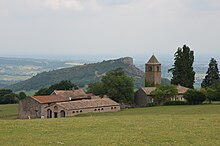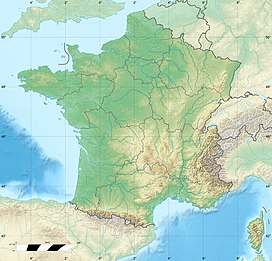Rock of Solutré
This article needs additional citations for verification. (October 2011) |
| Roche de Solutré | |
|---|---|
 The Rock of Solutré | |
| Highest point | |
| Elevation | 493 |
| Coordinates | 46°17′57″N 4°43′9″E / 46.29917°N 4.71917°E |
| Geography | |
| Parent range | Monts du Mâconnais |
The Rock of Solutré (French: Roche de Solutré) is a limestone escarpment 8 km (5.0 mi) west of Mâcon, France, overlooking the commune of Solutré-Pouilly. It is an iconic site in the department of Saône-et-Loire, in Bourgogne-Franche-Comté.
Protected by the French law on sites naturels classés and currently at the heart of a grand site national operation, it draws its fame severally as a rare geological phenomenon of the region, as a prehistoric site of the eponymous Solutrean paleolithic culture, and for the natural environment which its summit provides, the pelouse calciole grassland of Mâcon, with its distinctive flora and fauna. Occupied by humans for at least 55,000 years, it is also the cradle of the Pouilly-Fuissé wine appellation. It has attracted media coverage since the 1980s when French President François Mitterrand started to make ritual ascents of the peak once per year.
Physical setting
Geology
During the Mesozoic era, warm seas covered the region, as evidenced by the plentiful fossils to be found there. The Rock of Solutré, like its neighbour the Rock of Vergisson, was created from fossilized coral plateaus that developed approximately 160 million years ago in these seas.
In the Cenozoic era, eastern Burgundy underwent the effects of the alpine rising; while the Alps grew higher, the Saône basin sank. At the same time, plateaus rose in the west of the plain, then tumbled towards the east.
As these processes brought together landforms of differing natural composition,
Countryside

Surrounded by vineyards, the rock hosts a varied and spectacular country, from the height of its rocky peak or its grassy slopes. The Saône plain extends to the east, with a view of
In the three other directions the countryside is less open and bounded by the lines and crests of surrounding hills, with vineyards, villages, and typical Mâconnais settlements, in particular:
- to the north among the hills and vineyards, the village of Vergisson and its own outcrop ;
- to the west, the Roman road, and beyond, a mixed area of vineyards, groves and forests ;
- to the south, the village of Solutré-Pouilly and the Mont de Pouilly.
Prehistory
Solutré's remains from prehistoric times are some of the richest in Europe in bones and stone artifacts. Following their discovery, the Rock gave its name to a culture of the Upper Paleolithic, the Solutrean.
Chronology

Excavations at the foot of the rock started in 1866, in a place knowns as the "Cros du Charnier", on a protrusion of horse bones, which no one imagined at the time would date to prehistory, as archeology was just emerging as a scientific field at the time.
The zone of Upper Paleolithic homes was soon discovered by
Testot-Ferry and Adrien Arcelin decided to see if they could determine scientifically how large the deposit was that they had brought to light, and to examine with great care the remains that they had recovered. The challenge was to understand the arrangement of stratigraphic areas of the site, which would be the basis for establishing a chronology.
In 1868, the preferred scientific hypothesis viewed the site as a hunting station. The two discoverers called on specialists and presented their work at
In 1872, Gabriel de Mortillet, one of the most important prehistorians of his time, decided to name prehistoric periods after sites where they were particularly well presented. Thus the term "Solutrean" was born.
Numerous excavations were conducted thereafter. The excavation site remains protected, and partially unexplored, to this day.
Hunting site
The height of the sites in relation to the flood plain was the most important factor for human habitation. Providing shelter and food for migrant groups, the foot of the rock, strewn with debris, afforded hunters the opportunity to develop
The bone-laden magma can be explained by the fact that the site was used by four great paleolithic civilizations over the 25,000 years from 35,000 to 10,000 B.C, an extremely long time period.
The use of this site was therefore devoted to hunting activity,
Another legend told that the dog's domestication was made in Solutré where wolves cooperated with humans during "hunt into the abyss". This was also falsified in as the first
Human remains
Testot-Ferry and Arcelin also brought to light some
Paradoxically, despite the length of time when the site was in use, the Solutrean era was the only period in the Upper Paleolithic from which there are no human remains. Ultimately, one year after the first excavations carried out at the rock, remains of
Museum
The departmental history museum, a structure designed by the architect Guy Clapot from Strasbourg, is situated at the foot of the rock. The museum was encouraged by French President François Mitterrand, and was opened in 1987. Because of regulations in force at the site, the museum lies beneath a dome planted with vegetation, and is hardly visible from a distance. The places where the discoveries were made are presented in the museum along with a reconstructions of scenes from the hunt. The museum also hosts temporary exhibitions on subjects related to archeology, prehistory and ethnography.
From antiquity to the modern day
The rock's surroundings have been occupied continuously since pre-history, each epoch leaving its mark although sometimes almost invisible to the naked eye.
Antiquity
Traces have been discovered of two important
Post-antiquity
In the Middle Ages, the Rock of Solutré was a powerful high point, reputed to be the domain of
A high place for the French Resistance during World War II, the rock was ritually climbed each year by President François Mitterrand and certain of his friends.
A particular habitat: the pelouses calcicoles of Mâconnais
Human activities on and around the rock have had a visible impact on its profile. From the
The clearing at the peak and the soft slopes of the rock have contributed to the appearance and maintenance of a local habitat. In fact, until the middle of the 19th century, the wives of farmers herded their goats on these parcels of land surrounded by
The pelouses calcicoles grassland, also known as pelouses calcaires are also found on four other peaks formed in the same epoch (from north to south: Monsard, Mont de Leynes, the Rock of Vergisson, and finally Mont de Pouilly to the south of Solutré). They are protecteded under the French protections and sustainable development rules. When pasturing ceased after the Second World War, the area was colonized by boxtree, juniper and pedunculate oak.
Flora include
Notable birds of the rock include the
Viticulture
Introduced by the Romans, viticulture was practiced in the Middle Ages by Cluniac monks and penetrated the perimeter of the rock. Their phases of ebb and flow over the centuries entailed in turn the clearing of plots of land or their abandonment to the countryside. The area's predilection for Chardonnay has given rise to wines with international reputations:[1]
- Mâcon-Solutré (Mâcon-Villages)
- Saint-Véran
- Pouilly-Fuissé
Protection and sustainable development

The Rock had been partially protected by the law of 2 May 1930 on the protection of natural monuments and sites of artistic, historic, legendary or picturesque character, by virtue of its spectacular aspect and the archeological sites which it sheltered, and was part of the Natura 2000 network in the context of its pelouses calcioles grassland. These protections have turned out to be insufficient in the face of heavy visitation by locals and tourists, and the usure created on the site, and maintenance costs which are too heavy for the local communes.
From the 1990s the Rock has been officially made the focus of an Operation Grand Site. This law does not add any regulatory constraints but constitutes a tool for restoring and bringing value to the site, setting up a reception, and generating a dynamic local economy and a continuing management of the area.
Since 1995 trials have taken place to maintain the site as is involving e.g. grazing by Konik Polski horses and fighting colonization by boxtree through pasturing. The pathways have been revised to enhance safety for visitors and to stop the degradation of tracks, the parking lot has made way for a new one, which integrates almost completely with the landscape.[2]
Anecdotes
The 2009
Well-known quotations concerning the rock
- Sphinx aux griffes plantées dans les ceps (A Sphinx with claws planted in the vines)[citation needed]
- Deux navires pétrifiés surplombant une mer de vignes (Two petrified ships overlooking a sea of vineyards) Alphonse de Lamartine, speaking of the two rocks of Solutré Vergisson
- De là, j'observe ce qui va, ce qui vient, ce qui bouge et surtout ce qui ne bouge pas. (From there, I watch what comes and goes, what moves, and above all that which does not move.) François Mitterrand in La Paille et le Grain, 1978.
See also

- (in French) France's Grands Sites network
- (in French) Definition of an Opération Grand site (OGS) on the French Ministry of Ecology and Sustainable Development Website
- Head-Smashed-In Buffalo Jump
- Solutré horse
References
- ^ For more detail, see Burgundy wine
- ^ (in French) For more information see The official website of Grand Site de Solutré Pouilly Vergisson
Bibliography
- (in French) Paléontologie française, Henry de Ferry & Dr. de Fromentel, Paris, 1861
- (in French) L'Homme préhistorique en Mâconnais, Henry de Ferry, 1868
- (in French) Le Mâconnais préhistorique, Henry de Ferry, Paris, 1870
- (in French) Solutré ou les chasseurs de rennes de la France centrale, Adrien Arcelin, Paris, 1872
- (in French) Les fouilles de Solutré, Adrien Arcelin, Mâcon, 1873
- (in French) Annales de l'Académie de Mâcon, 1869–1906
- (in French) 1866 : l'invention de Solutré, 1989 Summer exhibition catalogue of the Musée Départemental de Préhistoire de Solutré
- (in French) Solutré, 1968–1998, Jean Combier et Anta Montet-White (dir.), (2002), Mémoire de la Société Préhistorique française XXX, ISBN 2-913745-15-6

